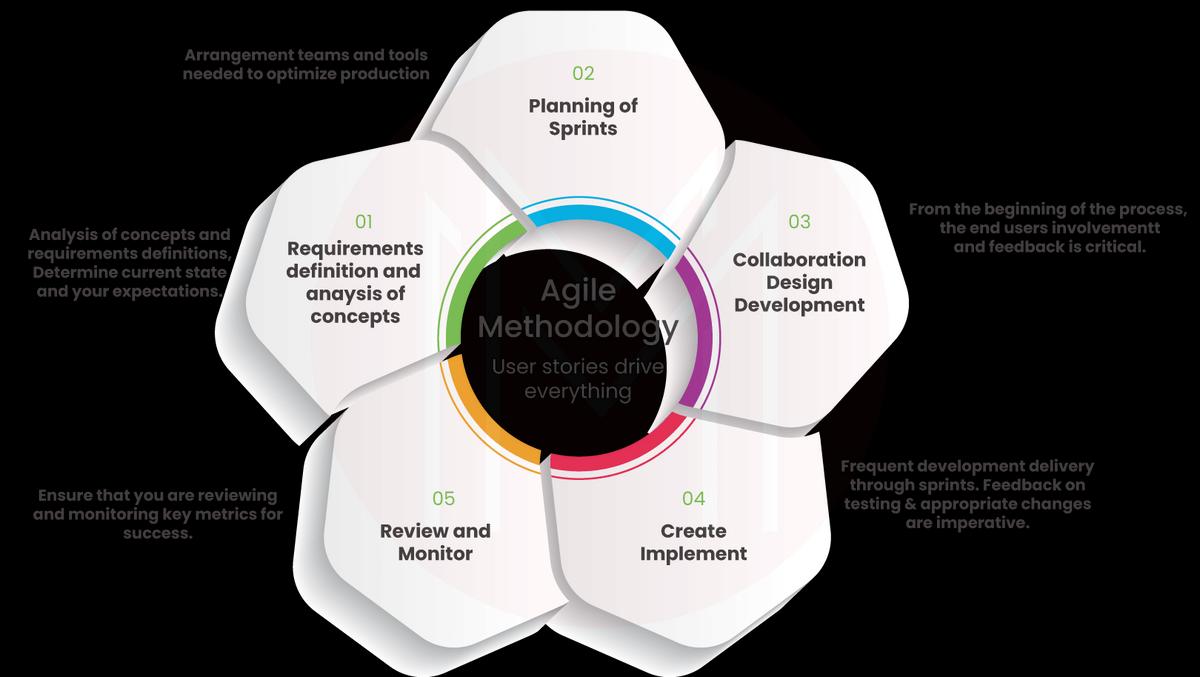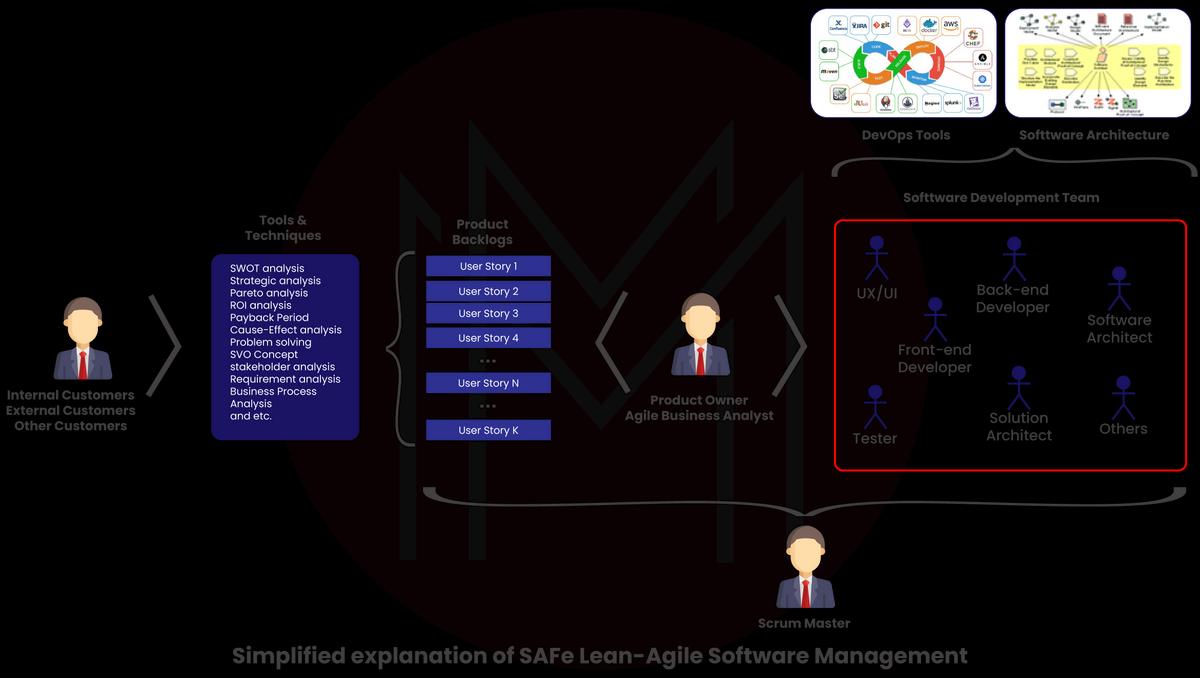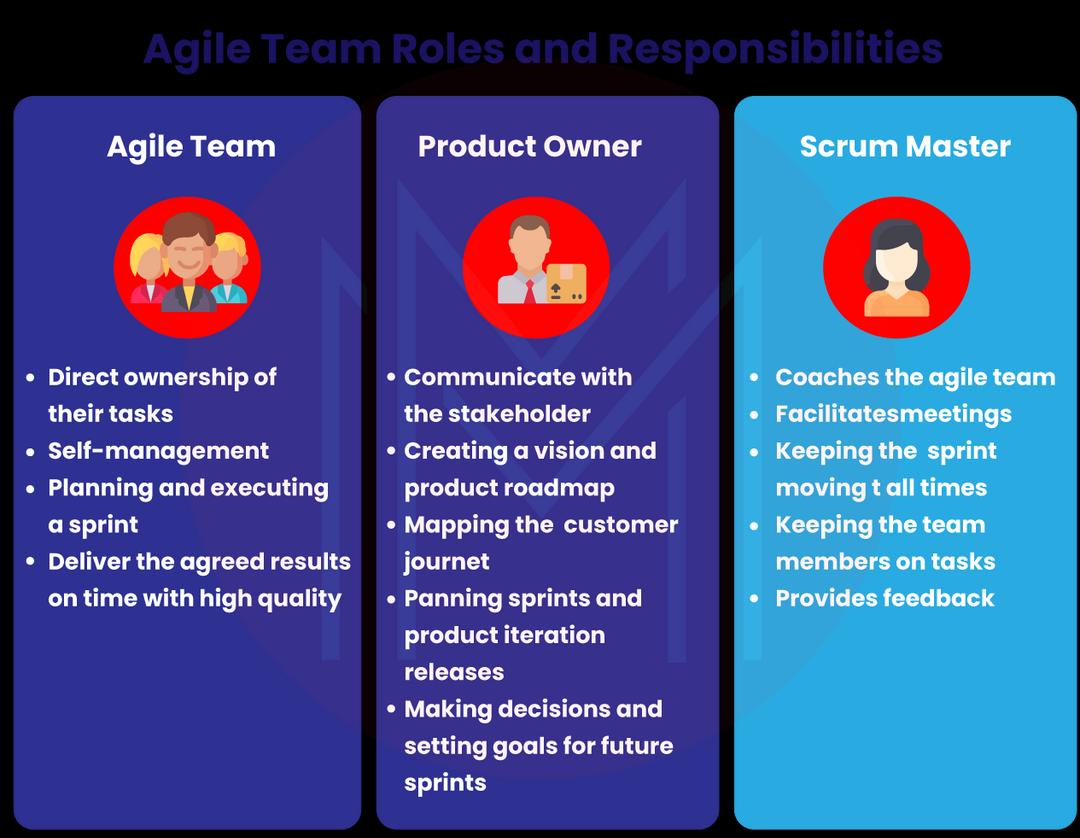SAFe methodology vs Agile is two powerful frameworks for managing software development projects. Combining Agile principles with SAFe strategies has helped organizations scale their extensive efforts and ensure consistency across multiple teams.
In 2019, nearly 80 percent of organizations globally were using some form of Agile methodology. Of that figure, about one-third of the organizations are using SAFe vs Agile. With the growing demand for Agile software development, the global market for agile project management software is expected to reach $82.7 billion by 2023.
If you are confused In picking between the two frameworks, read below the complete overview for both.
What is Agile Methodology?
Agile methodology is a project management approach that facilitates the development of iterative and incremental software solutions. It is a set of principles and practices based on the Agile Manifesto, a set of values and guiding principles for software development. An agile methodology is an iterative approach that emphasizes flexibility and collaboration between team members, such as developers, designers, testers, and business stakeholders. It encourages teams to prioritize customer needs, break tasks into smaller chunks, and deliver incremental results regularly.
Agile methodology is based on the following objectives:
- Interactions among individuals over processes and tools.
- Working software over comprehensive documentation.
- Customer collaboration over contract negotiation.
- Responding to change over following a plan.
These objectives guide teams in their software development approach, helping them focus on customer needs, work collaboratively, and respond quickly to changes in the environment.

| If you want to enrich your career and become a professional in Agile, then visit Mindmajix - a global online training platform: "Agile Online Training" This course will help you to achieve excellence in this domain |
What is the Scaled Agile Framework (SAFe)?
The Scaled Agile Framework (SAFe) is an approach to scaling agile development that enables teams to deliver high-quality software solutions. It is a set of principles and practices based on the Agile Manifesto, a set of values and guiding principles for software development. SAFe is an iterative approach that focuses on customer needs, breaks tasks into smaller chunks, and delivers incremental results regularly.
SAFe is based on four objectives: Alignment, Built-In Quality, Transparency, and Program Execution. These objectives guide teams in their software development approach, helping them focus on customer needs, work collaboratively, and respond quickly to changes in the environment.

Comparison Between Agile and SAFe
Principles: SAFe vs Agile
The core values of Agile vs SAFe are very similar, as they both emphasize collaboration, customer needs, and responding to change. Following are the differences between the two.
SAFe Principles
Below are the SAFe principles that guide teams to work effectively.
Economic Perspective
When considering any solution or decision, SAFe Principle recognizes the importance of understanding the economic perspective of the change. This includes analysing the impact of any proposed changes on the stakeholders and understanding the potential cost/benefit of the change.
- Apply System Thinking: SAFe Principle encourages using system thinking to evaluate the impact of any proposed changes. This includes looking at the holistic system, considering how the various parts interact, and how any change will affect the System as a whole.
- Assumption of Variability: SAFe Principle acknowledges that the environment changes over time and encourages teams to plan for the variability and make the best decisions for the team and organization in the long run.
- Build Incrementally: SAFe Principle encourages teams to build incrementally and to focus on delivering value quickly. This includes breaking down large tasks into smaller pieces, testing and validating results early and often, and making adjustments as needed.
- Visualize Current Work Processes: SAFe Principle promotes using visual models to help teams better understand their current work processes and how they can be improved. This includes creating visual models of the existing process and exploring how any proposed changes would affect the system.
Agile Principles
Below are the SAFe principles that ensure effective work for the organization.
- Teamwork: The Agile Principle promotes teamwork to achieve a shared goal. This includes working together towards a common purpose, valuing different perspectives, and allowing team members to contribute in the most comfortable way.
- Community: Agile Principle encourages teams to foster collaboration and open communication. This includes recognizing the value of different experiences, listening to different perspectives, and creating an open and inclusive environment.
- Flexibility: Agile Principle encourages teams to be flexible in their approach to problem-solving and decision-making. This includes being open to new ideas, adapting to changing circumstances, and embracing ambiguity.
- Pragmatism: The Agile Principle promotes practical, realistic solutions and encourages teams to focus on results rather than following a rigid process. This includes being mindful of resources and time constraints and making the best decisions for the situation.
Strategies: SAFe vs Agile
The strategies of Agile and SAFe are also very similar, as they both emphasize breaking tasks into smaller chunks and delivering incremental results regularly. Following are the differences between the two on the basis of strategy:
SAFe Strategies
- Establish a clear mission or vision for the team aligned with the organization's strategy.
- Foster collaboration and communication between teams and departments to ensure alignment and shared understanding.
- Implement Lean and Agile principles to ensure speed and agility.
- Create a backlog of business and technical initiatives to prioritize and track progress.
- Utilize DevOps practices to increase automation and reduce time to market.
- Create feedback loops to capture customer insights and drive continuous improvement.
- Leverage data-driven decision-making and analytics to monitor performance and optimize outcomes.
Agile Strategies
- Embrace an iterative, incremental approach to development and delivery.
- Utilize Agile methodologies such as Scrum, Kanban, and Lean.
- Encourage collaboration and communication among teams.
- Implement an adaptive, flexible approach to change and adaptation.
- Leverage data-driven decision-making to optimize outcomes.
- Foster cross-functional teams with the right skills and knowledge.
- Rely on continuous feedback loops to capture customer insights.
Core Values: SAFe vs Agile
The core values of Agile and SAFe are very similar however below are some differences between the two.
SAFe Core Values
SAFe core values are elaborated below:
- Alignment: Alignment is about creating an environment where everyone works together towards a common goal. It means having a shared understanding of the overall objectives and ensuring all the teams involved in the project are in sync with each other.
- Built-in Quality: Quality is an essential part of the SAFe Agile framework and is built into the entire process. This means that everyone involved in the project is held to a high standard of excellence and that all components are tested and evaluated before release.
- Transparency: Transparency is about ensuring that all of the stakeholders involved in the project have the necessary visibility into the project's progress. This helps to ensure that everyone is on the same page and that there are no surprises along the way.
- Program Execution: Program execution is about ensuring that all project components come together promptly and effectively. It means ensuring that all tasks are completed on schedule and that the deliverables are high quality.
Agile Core Values: Agile core values are elaborated below:
- Individuals and Interactions Over Processes And Tools: Agile values individuals and their interactions over processes and tools. It is more important to focus on how people work together and communicate than on the tools and processes used.
- Working Software Over Comprehensive Documentation: Agile values working software over comprehensive documentation. Focusing on producing a working product is more important than creating extensive technical documentation.
- Customer Collaboration Over Contract Negotiation: Agile values customer collaboration over contract negotiation. Focusing on customer needs and feedback is more important than specific contractual agreements.
- Responding to Change Over Following a Plan: Agile values responding to change over following a plan. It is more important to be flexible and open to new ideas and approaches than to follow a predetermined plan rigidly.
Benefits Obtained: SAFe Agile vs Agile
The benefits obtained from Agile vs SAFe are very similar, as they enable teams to deliver better software solutions. Below are the differences between the two.
-
SAFe Benefits: SAFe provides an integrated framework of principles and practices that bring together Lean-Agile values, processes, and techniques to help organizations deliver greater value. Benefits of SAFe include increased team collaboration, greater agility and responsiveness, improved quality, faster delivery of value, and improved program predictability, among others. It also provides an integrated view of the organization, allowing teams to collaborate more effectively and respond faster to customer needs.
-
Agile Benefits: Agile is a set of values, principles, and practices that helps organizations become more flexible and adaptive to changing customer needs, market conditions and technological advances. Agile teams can respond quickly to customer feedback, deliver higher-quality products and services, and reduce time to market. Agile also helps teams focus on delivering value and creating a culture of continuous improvement and learning. Agile teams are better able to collaborate, communicate effectively, and make decisions faster.
Pros and Cons of SAFe
The pros of SAFe include focusing on customer needs, breaking tasks into smaller chunks, and regularly delivering incremental results. Additionally, it encourages teams to collaborate to ensure that everyone is working towards the same goal.
The cons of SAFe include the need for a larger team and the additional complexity of scaling agile.
Pros and Cons of Agile
The pros of Agile include the ability to focus on customer needs, break tasks into smaller chunks, and deliver incremental results regularly. Additionally, it encourages teams to collaborate to ensure that everyone is working towards the same goal.
The cons of Agile include the need for a larger team and the additional complexity that comes with scaling agile.
Key Roles of SAFe vs Agile and Salaries
Key Roles of SAFe
The key roles in a SAFe environment include Program Manager, Feature Team Member, Product Manager, Scrum Master, and Release Train Engineer. The Program Manager oversees the entire program, sets expectations, and ensures that the program meets its goals. The Feature Team Member is responsible for developing the features that make up the program. The Product Manager is responsible for understanding customer needs and translating them into product requirements. The Scrum Master is responsible for facilitating the Scrum process, ensuring that the team works collaboratively, and helping the team stay on track. Finally, the Release Train Engineer ensures that the program is delivered on time and within budget.
Key Roles of Agile
The key roles in an Agile environment include Product Owner, Scrum Master, and Team Member. The Product Owner is responsible for understanding customer needs and translating them into product requirements. The Scrum Master is responsible for facilitating the Scrum process, ensuring that the team works collaboratively, and helping the team stay on track. The Team Member is responsible for developing the features that make up the product.

Related Article: Scrum Master Interview Question
Salaries: SAFe vs Agile
The total pay for a SAFe Agilist and Agile Scrum Master is $146,805 per year in the United States area, with an average salary of $116,706 per year. The current reference salary in the USA is $7.25, but it is different throughout the country since states and local governments can establish their minimum wages.
Related Article: Agile vs Scrum
SAFe vs Agile FAQs
1. What is the difference between SAFe and Agile?
SAFe is an agile framework for enterprise-level software development, while agile is an umbrella term for various iterative software development methodologies.
2. Is SAFe better than Scrum?
The comparison of both are quite difficult as it depends on the context and needs of the organization. SAFe vs Agile Scrum is a comprehensive approach to agile, which some organizations may find more beneficial than just Scrum alone.
3. How is SAFe Agile different from Scrum?
SAFe is based on the principles of Scrum but adds additional layers of complexity to address enterprise-level needs. The main differences between SAFe and Scrum are scale, complexity, and the level of coordination needed to succeed.
4. Is SAFe truly Agile?
Yes, SAFe is a truly agile framework that combines Scrum, Kanban, XP, Lean, and DevOps best practices to help organizations increase their agility and adapt to change.
5. Why is SAFe better than Agile?
SAFe offers a comprehensive approach to agile, which can help organizations better manage complex projects and scale agile across the enterprise. It also guides how to implement agile principles and practices.
6. What are the 4 core values of SAFe?
The four core values of SAFe are alignment, built-in quality, transparency, and program execution.
Conclusion
When deciding which framework to use, it is important to consider the size and complexity of the project. SAFe is best suited for larger, more complex projects, whereas Agile is better for smaller, simpler projects. It is also important to consider the resources available and the team's experience with the two frameworks.
In conclusion, both SAFe vs Agile provide a great framework for project management. They both have advantages and disadvantages and should be carefully considered before deciding. However, given its popularity and usage in large-scale projects, SAFe may be the better option for many organizations.
If you want to enrich your career and become a professional in Agile, then visit Mindmajix - a global online training platform: "Agile Online Training" This course will help you to achieve excellence in this domain
 On-Job Support Service
On-Job Support Service
Online Work Support for your on-job roles.

Our work-support plans provide precise options as per your project tasks. Whether you are a newbie or an experienced professional seeking assistance in completing project tasks, we are here with the following plans to meet your custom needs:
- Pay Per Hour
- Pay Per Week
- Monthly
| Name | Dates | |
|---|---|---|
| Agile Training | Jan 10 to Jan 25 | View Details |
| Agile Training | Jan 13 to Jan 28 | View Details |
| Agile Training | Jan 17 to Feb 01 | View Details |
| Agile Training | Jan 20 to Feb 04 | View Details |

Madhuri is a Senior Content Creator at MindMajix. She has written about a range of different topics on various technologies, which include, Splunk, Tensorflow, Selenium, and CEH. She spends most of her time researching on technology, and startups. Connect with her via LinkedIn and Twitter .














